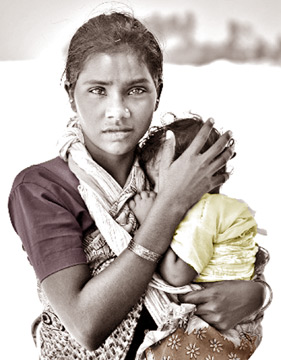|

Is your girl child nutritionally deficient?
By Carol Aloysius
Adolescence: The transitional period between childhood and adulthood.
From a developmental point of view, this is the period between puberty
and maturity which usually falls within the teenage years.
It is this period that rapid biological changes occur - physical,
psychological and social that pose special challenges to the adolescent
girl or boy.
For girls especially this is an important period for they experience
rapid spurts of development both emotionally and sexually, which unless
they receive all their nutritional needs, can leave adverse impacts on
their health and those of the children they bear.
 The National Nutrition Month which recently concluded brought to
attention a shocking fact: that many of our girl children from the
primary grades through adolescence to womanhood, are anaemic, suffer
from iron deficiency and malnourished. The fact that the state has spent
millions of rupees providing free meals and other food supplements to
halt this frightening trend, helped by UN organisations such as UNICEF
and UNDP, has it seems, not seen a visible reduction in anaemia, iron
deficiency and malnutrition or under nutrition among both mothers and
school children. The National Nutrition Month which recently concluded brought to
attention a shocking fact: that many of our girl children from the
primary grades through adolescence to womanhood, are anaemic, suffer
from iron deficiency and malnourished. The fact that the state has spent
millions of rupees providing free meals and other food supplements to
halt this frightening trend, helped by UN organisations such as UNICEF
and UNDP, has it seems, not seen a visible reduction in anaemia, iron
deficiency and malnutrition or under nutrition among both mothers and
school children.
Recent studies reveal that 1: 6 persons in this country are
nutritionally deficient and some 16.3 percent of babies low weight.
A micronutrient survey by the Medical Research Institute in 2012 says
around 15 percent of preschoolers and 20 percent of school children are
anaemic, while the National Food Security survey of 2009 reveals anaemia
being prevalent among 22 percent non pregnant women aged between 15-49
years.
Nutritionally deficient girl children face several adverse health
impacts could have been avoided if they were better informed and
protected from infancy to adulthood.
To find out what these health risks are and how they could be
avoided, The Sunday Observer spoke to two Nutrition experts.
Director Coordination, Nutrition Unit of the Health Ministry, Dr
Shanthi Gunawardane:
Q. Why is nutrition so important for the girl child?
A. Nutrition is vital to everyone irrespective of gender or
age. It begins from conception and continues through puberty to
adolescence to maturity.
Q. Why?
A. To maintain good health throughout our lives. If a pregnant
woman is well nourished and receives enough nutrients she will have a
healthy baby who will someday become a healthy adult.
Q. What happens if a mother is anaemic and malnourished during
her pregnancy and delivers a low weight baby?
A. It is likely that both the mother and baby will have some
serious health problems, that will require close monitoring.
If the foetus is deprived of proper nutrients it is likely that the
mother will deliver a low weight baby i.e. below 2.5 kgs, who will be
more prone to infections, have slow body and brain growth and
development. A foetus inside an anaemic mother will grow in a
nutritionally deficient environment and will be under tension or
pressure while in his/her mother's womb. This will affect the child's
nervous system and the whole body system. He will have low immunity and
be malnourished.
The first 1,000 days of a child's life is known as the ‘Golden Days
of the life of a child’. This is calculated from the period of
conception (nine months or 280 days) upto the time of delivery and
thereafter the first two years of his /her life. It is during this
period that the child receives the stimulation, food and nutritional
environment that will directly affect his/ her future.
Q. Since we are speaking specifically about the girl child,
tell us what happens to a girl who doesn't receive proper nutrients
during this period of her life?
A. We have to carefully monitor the child's development and
growth for the first five years at first, and continue to monitor her
growth till she reaches maturity.
Q. At what age does the girl child need most nutrition?
A. The first five years will see a rapid growth in the girl's
body. This will continue till she is around 10 years although the pace
of growth is not so rapid as in the first five years of her life. Then
from about 15 years to 19 years will see another spurt of growth when
she reaches adolescence.
If a girl child is born with nutritional deficiencies, we can
carefully monitor her nutritional levels during the next 10 years so
that these adverse effects can be counteracted before she reaches
maturity.
Q. Is it true that the girl child require more nutrition than
the boy child? Why?
A. Because of their rapid growth spurt at a comparatively
earlier age than boys, they need more energy, protein, fat, vitamins A,
B, C, D, K and minerals, iron, calcium, phosphorous, iodine and zinc for
their bodies that are growing and developing physically and emotionally.
Q. Does the average girl child in Sri Lanka get all these
nutrients in her daily diet?
A.Unfortunately no. Because of their emotional changes, most
young girls are conscious of the Body Beautiful image/ They stop eating
to become thin like their favourite supermodel or film star or very
little and suffer from anorexia.
A few also suffer from Bulimia where they eat a lot and vomit out the
food immediately afterwards to remain thin.
Q. So the result of all this is...?
A. Eventually, they become malnourished and anaemic and suffer
from from iron deficiency anaemia(IDA). They will have a low body mass
index (BMI) and if their nutritional status does not improve at the time
of their marriage and period of pregnancy, they will give birth to low
weight babies.
Q. What advice can you give to the adolescent girl?
A. Take at least three meals a day. Don't skip your breakfast
as it is the first meal after your last night meal. A glass of milk
instead of a full balanced breakfast will not provide you with all the
nutrients you need, as milk is only one of them.
Make sure you follow it up with an equally balanced lunch and dinner.
Q. What nutrients are required to make up a balanced meal?
A. Energy giving foods, fats (soluble fats), Protein and
Minerals as well as vitamins, calcium zinc, iron, iodine.
Energy foods include cereals like rice, kurakkan, maize, wheat, oats,
yams. In Sri Lanka we have over 40 varieties of yams to choose from -
manioc as well as jak, breadfruit, sweet potato. Vitamin solubles are
found in vitamins A, D, C and K which are necessary to keep your skin
smooth. Soluble fats are found in butter, coconut oil, minerals and
proteins are found in fish, meat and dairy products, lentils, cowpea,
dhal.
Q. Till what age do most girls require these nutrients?
A. Till the age of 20 all children (male and female) require
these nutrients, body building and protective foods, as they are part of
our enzymes and hormones in our body. Iodine is also important
especially for the girl child to produce thyroxine which is important
for them to attain menarche and give their bodies shape i.e. Attain
secondary sexual characteristics that lead to physical and emotional
changes.
Q. What happens if they don't get this nutrient?
A. Then the entire body gets affected. You can get enough
thyroxine from small fish, green leaves, water, salt and vegetables and
fruits. The colour is important as the pigments contain body protective
substances e.g. Beetroot has carotene. So have yellow coloured
vegetables. And fruits.
If you don't eat enough protein it will affect your bone density.
Over 90 percent of bone density develops during this period. So eat
plenty of sprats, fish, milk, lentils and fruit.
Lastly, exercise. Go out and play and breathe in the fresh oxygen to
expand your lungs and help you think better.
Consultant Community Nutritionist Visaka Tillekeratne
Q. What do you see as the role of the girl child in tomorrow's
world?
A. The girl child is the future mother. This is why her
nutrition level is so important.
Q. You have done some studies on the extent of nutrition
levels of the girl child here. What are your findings?
A. Or our total population about 30 percent are deficient in
iron and most of these persons are women. One is to four girls are
anaemic and not energetic and don’t deliver correct weight babies above
2.5 kgs. Over 6.2 percent of babies are born underweight.
Girls tend to lose blood when they get their periods every month and
unless this blood is replaced they can get anaemic, lethargic and less
active and later give birth to low weight babies. Iron deficiency in the
body means that other nutrients also don’t get metabolised.
Q. Your comments on the average Lankan diet?
A. In Sri Lanka most diets are energy deficient and of poor
quality. This is because of the lack of diversity in the food.
My studies in Trincomalee showed that the population in the poorer
areas eat only half the variety of their daily requirements.
In Sri Lanka there are about15 food groups. But because of poverty
and other factors, many people eat only about eight of the foods they
require from each of these categories.
Q. Food myths? Do they affect the girl child?
A. Traditional beliefs and customs often prevent the girl
child to get sufficient nutrients at the time she most needs them, e.g.
at puberty or when she is menstruating or in pregnancy.
Wrong beliefs about various foods being ‘heaty’ ‘cooling’ and allergy
causing can prevent the girl child from getting sufficient minerals,
proteins, and fats in her body.
Q. Any other contributory factors that put the pregnant woman
at risk?
A. Pregnant women in rural areas are often forced to walk long
distances in search of labour.
This can deprive the foetus of energy and cause the mother to deliver
a pre-term low weight baby.
Q. What abbot emotional and psychological effects on young
girls growing up in deprived communities and nutritionally deficient
environments?
A. Living in impoverished neighbourhoods that lack sanitation
and access to safe water and eating low quality nutritionally deficient
meals can lead to mental and emotional stress. This can affect the
unborn child. In addition, in rural areas many mothers still cook on
open fires in enclosed smoking kitchens which is also bad for them and
affects the foetus.
Q. Don't the authorities provide suitable interventions for
these underprivileged mothers-to-be?
A. Yes. But compliance is still an issue. Which is why we urge
all mothers who receive these nutritional supplements such as Thriposha
and iodine and folic acid and vitamin E and C from the Health Minisrty,
to continue taking them to avoid complications when delivering.
Better sleep quality and duration improve cognition in ageing
populations
Maybe turning to sleep gadgets - wristbands, sound therapy and
sleep-monitoring smartphone apps - is a good idea. A new University of
Oregon-led study of middle-aged or older people who get six to nine
hours of sleep a night think better than those sleeping fewer or more
hours.
 The study, reaffirms numerous small-scale studies in the United
States, Western Europe and Japan, but it does so using data compiled
across six middle-income nations and involving more than 30,000 subjects
for a long-term project that began in 2007. The study, reaffirms numerous small-scale studies in the United
States, Western Europe and Japan, but it does so using data compiled
across six middle-income nations and involving more than 30,000 subjects
for a long-term project that began in 2007.
“We wanted to look at aging, particularly dementia and cognitive
decline as people get older, and the importance of sleep.
Our results provide compelling evidence that sleep matters a lot,”
said lead author Theresa E. Gildner, a doctoral student in the UO's
anthropology department.
“In all six countries, which are very different culturally,
economically and environmentally - despite all these differences - you
see similar patterns emerging.”
The study, based on the first wave of data from a continuing
long-term project, focuses on people 50 years old and older in China,
Ghana, India, Mexico, the Russian Federation and South Africa. Among the
key findings were:
- Men reported higher sleep quality than women in all six nations,
with men and women in Mexico reporting the highest.
- Women reported longer sleep durations than men in all countries
except Russia and Mexico. Men and women in South Africa slept longer
than in any other country. The least sleep hours for both sexes occurred
in India.
- Individuals sleeping less than six hours and more than nine hours
had significantly lower cognitive scores compared to those in the
intermediate group.
Trained native speakers in each country interviewed the participants,
who rated their sleep quality on a five-point scale and the number of
hours they'd slept over the two previous nights.
That information was averaged. Participants then went through five
standard cognitive tests involving immediate recall of a list of
presented words, delayed recall of those words later, forward and
backward recall of long lists of numbers, and a verbal fluency test in
which they listed as many animals as possible without repetition, the
use of proper nouns or descriptors.
The study concludes that the findings have important implications for
future intervention strategies for dementia.
The consistent associations between intermediate sleep durations,
high sleep quality and enhanced cognitive performance in these diverse
populations suggests that improving sleep patterns may help reduce the
level of cognitive decline as seen in older adults.
Another important finding, Gildner said, is the gender difference in
all sleep and cognition variables.
Citing previous studies, the authors hypothesised that women's sleep
patterns reflect postmenopausal changes, increased bladder instability
and feelings of isolation after the loss of a spouse or lack of social
support.
Cognition scores of women may result from their sleep difficulties
and/or lower educational levels.
The growing database in the long-term study, known as the Study on
global AGEing and adult health (SAGE), is allowing researchers to mine
many combinations of variables connected to health and lifestyle, said
J. Josh Snodgrass, professor of anthropology at the UO.
“It also will allow anthropologists to explore cultural factors that
may contribute to sleeping and health patterns.”
Snodgrass is a key investigator on SAGE, which is funded by a joint
agreement of the National Institutes of Health and the World Health
Organization.
“This study is hugely powerful and so different from what's been done
in the past, simply because of the consistency of how the data was
collected - multi-national, random samples of people,” he said.
“Sleep is something that is important but often undervalued in our
society.
“From doing this research and being familiar with the literature,” he
said, “an emphasis on sleep issues by the media in recent years is
warranted. Every single piece of evidence that people look at now as
they are investigating sleep and different health associations is all
showing that sleep really, really, really matters.
We're just now scratching the surface on what patterns of sleep
normally are, and also what are these associations between sleep and
health issues.”
- MNT
Little-known heart condition affects educated young women
|

The condition causes the heart rate to accelerate
rapidly upon standing up |
Postural tachycardia syndrome is believed to affect around one in 558
people
A debilitating and poorly understood health condition which causes
the heart rate to accelerate rapidly upon standing up predominantly
affects young, well educated women, new evidence has shown.
Researchers who set out to understand more about the rare postural
tachycardia syndrome (PoTS) discovered that sufferers had an average age
between 30 and 33, and were more likely to be educated to degree or
postgraduate degree level.
The reasons for the association remain mysterious. PoTS is believed
to affect around one in 558 people, based on figures from the USA, but
many doctors are still unaware of its existence. It is often
misdiagnosed, or attributed to an associated condition such as anxiety,
panic disorder, or chronic fatigue.
The new study, assessed 84 members of the national support group PoTS
UK, and 52 patients diagnosed at an NHS clinic in Newcastle.
Many had been forced to change jobs or give up work by the condition,
which causes fatigue and makes many basic, everyday tasks exhausting and
difficult.
Researchers said that increasing awareness of the condition would be
crucial to improving diagnosis rates and understanding.
- The Independent
|

